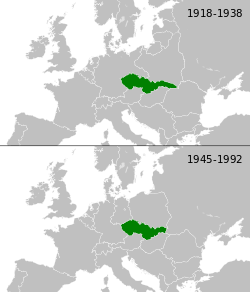
Back Tsjeggo-Slowakye Afrikaans Tschechoslowakei ALS ቸኮስሎቫኪያ Amharic Checoslovaquia AN Cecoslofacia ANG تشيكوسلوفاكيا Arabic تشيكوصلوڤاكيا ARY تشيكوسلوفاكيا ARZ Checoslovaquia AST Çexoslovakiya Azerbaijani
This article appears to be both in categories to be diffused and in their subcategories, or is in too many categories, and may need cleanup. (October 2024) |
Czechoslovakia Československo[a] | |||||||||||
|---|---|---|---|---|---|---|---|---|---|---|---|
| 1918–1939 (1939–1945 Government-in-exile) 1945–1992 | |||||||||||
| Motto: 'Pravda vítězí / Pravda víťazí' (Czech / Slovak, 1918–1990) 'Veritas vincit' (Latin, 1990–1992) 'Truth prevails' | |||||||||||
| Anthem: 'Kde domov můj' (Czech) and 'Nad Tatrou sa blýska' (Slovak) | |||||||||||
 Czechoslovakia during the interwar period and the Cold War | |||||||||||
| Capital and largest city | Prague 50°05′N 14°25′E / 50.083°N 14.417°E | ||||||||||
| Official languages | Czechoslovak, after 1948 Czech · Slovak | ||||||||||
| Recognised languages | |||||||||||
| Demonym(s) | Czechoslovak | ||||||||||
| Government | First Republic (1918–38) Second Republic (1938–39) Third Republic (1945–48) Socialist Republic (1948–89) Federative Republic (1990–92) Details
| ||||||||||
| President | |||||||||||
• 1918–1935 | Tomáš G. Masaryk | ||||||||||
• 1935–1938 · 1945–1948 | Edvard Beneš | ||||||||||
• 1938–1939 | Emil Hácha | ||||||||||
• 1948–1953 | Klement Gottwald | ||||||||||
• 1953–1957 | Antonín Zápotocký | ||||||||||
• 1957–1968 | Antonín Novotný | ||||||||||
• 1968–1975 | Ludvík Svoboda | ||||||||||
• 1976–1989 | Gustáv Husák | ||||||||||
• 1989–1992 | Václav Havel | ||||||||||
| KSČ General Secretary / First Secretary | |||||||||||
• 1948–1953 | Klement Gottwald | ||||||||||
• 1953–1968 | Antonín Novotný | ||||||||||
• 1968–1969 | Alexander Dubček | ||||||||||
• 1969–1987 | Gustáv Husák | ||||||||||
• 1987–1989 | Miloš Jakeš | ||||||||||
| Prime Minister | |||||||||||
• 1918–1919 (first) | Karel Kramář | ||||||||||
• 1992 (last) | Jan Stráský | ||||||||||
| Legislature | Revolutionary National Assembly (1918–1920) National Assembly (1920–1939) Interim National Assembly (1945–1946) Constituent National Assembly (1946–1948) National Assembly (1948–1969) Federal Assembly (1969–1992) | ||||||||||
| History | |||||||||||
| 28 October 1918 | |||||||||||
| 30 September 1938 | |||||||||||
| 14 March 1939 | |||||||||||
| 10 May 1945 | |||||||||||
| 25 February 1948 | |||||||||||
| 21 August 1968 | |||||||||||
| 17 – 28 November 1989 | |||||||||||
| 1 January 1993 | |||||||||||
| HDI (1990 formula) | 0.897[1] very high | ||||||||||
| Currency | Czechoslovak koruna | ||||||||||
| Drives on | Left (Pre 1939) right (Post 1939) | ||||||||||
| Calling code | +42 | ||||||||||
| ISO 3166 code | CS | ||||||||||
| Internet TLD | .cs | ||||||||||
| |||||||||||
| Today part of | |||||||||||
Calling code +42 was withdrawn in the winter of 1997. The number range was divided between the Czech Republic (+420) and Slovak Republic (+421). Current ISO 3166-3 code is "CSHH". | |||||||||||
Czechoslovakia[2] (/ˌtʃɛkoʊsloʊˈvæki.ə, ˈtʃɛkə-, -slə-, -ˈvɑː-/ ⓘ CHEK-oh-sloh-VAK-ee-ə, CHEK-ə-, -slə-, -VAH-;[3][4] Czech and Slovak: Československo, Česko-Slovensko)[5][6] was a landlocked country in Central Europe,[7] created in 1918, when it declared its independence from Austria-Hungary. In 1938, after the Munich Agreement, the Sudetenland became part of Nazi Germany, while the country lost further territories to Hungary and Poland (the territories of southern Slovakia with a predominantly Hungarian population to Hungary and Zaolzie with a predominantly Polish population to Poland). Between 1939 and 1945, the state ceased to exist, as Slovakia proclaimed its independence and Carpathian Ruthenia became part of Hungary, while the German Protectorate of Bohemia and Moravia was proclaimed in the remainder of the Czech Lands. In 1939, after the outbreak of World War II, former Czechoslovak President Edvard Beneš formed a government-in-exile and sought recognition from the Allies.
After World War II, Czechoslovakia was reestablished under its pre-1938 borders, with the exception of Carpathian Ruthenia, which became part of the Ukrainian SSR (a republic of the Soviet Union). The Communist Party seized power in a coup in 1948. From 1948 to 1989, Czechoslovakia was part of the Eastern Bloc with a planned economy. Its economic status was formalized in membership of Comecon from 1949 and its defense status in the Warsaw Pact of 1955. A period of political liberalization in 1968, the Prague Spring, ended when the Soviet Union, assisted by other Warsaw Pact countries, invaded Czechoslovakia. In 1989, as Marxist–Leninist governments and communism were ending all over Central and Eastern Europe, Czechoslovaks peacefully deposed their communist government during the Velvet Revolution, which began on 17 November 1989 and ended 11 days later on 28 November when all of the top Communist leaders and Communist party itself resigned. On 31 December 1992, Czechoslovakia peacefully split into the two sovereign states of the Czech Republic and Slovakia.[8]
Cite error: There are <ref group=lower-alpha> tags or {{efn}} templates on this page, but the references will not show without a {{reflist|group=lower-alpha}} template or {{notelist}} template (see the help page).
- ^ "Human Development Report 1992" (PDF). hdr.undp.org. Archived (PDF) from the original on 9 October 2022.
- ^ "THE COVENANT OF THE LEAGUE OF NATIONS". Archived from the original on 20 May 2011. Retrieved 12 April 2011.
- ^ Wells, John C. (2008), Longman Pronunciation Dictionary (3rd ed.), Longman, ISBN 978-1-4058-8118-0
- ^ Roach, Peter (2011), Cambridge English Pronouncing Dictionary (18th ed.), Cambridge: Cambridge University Press, ISBN 978-0-521-15253-2
- ^ "Ján Kačala: Máme nový názov federatívnej republiky (The New Name of the Federal Republic), In: Kultúra Slova (official publication of the Slovak Academy of Sciences Ľudovít Štúr Institute of Linguistics) 6/1990 pp. 192–197" (PDF). Archived (PDF) from the original on 19 August 2011. Retrieved 5 April 2010.
- ^ Czech pronunciation: [ˈtʃɛskoslovɛnsko], Slovak pronunciation: [ˈtʂeskɔslɔʋenskɔ].
- ^ "Milestones: 1961–1968 – Office of the Historian". history.state.gov. Retrieved 27 January 2021.
- ^ Rozdělení Československa, Vladimír Srb, Tomáš Veselý ISBN10809685335x

